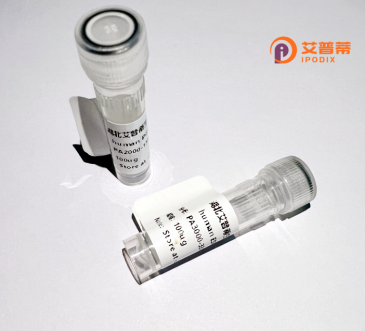
| 纯度 | >90%SDS-PAGE. |
| 种属 | Human |
| 靶点 | FAM45A |
| Uniprot No | Q8TCE6 |
| 内毒素 | < 0.01EU/μg |
| 表达宿主 | E.coli |
| 表达区间 | 1-357aa |
| 氨基酸序列 | MAAAEVADTQLMLGVGLIEKDTNGEVLWVWCYPSTTATLRNLLLRKCCLTDENKLLHPFVFGQYRRTWFYITTIEVPDSSILKKVTHFSIVLTAKDFNPEKYAAFTRILCRMYLKHGSPVKMMESYIAVLTKGICQSEENGSFLSKDFDARKAYLAGSIKDIVSQFGMETVILHTALMLKKRIVVYHPKIEAVQEFTRTLPALVWHRQDWTILHSYVHLNADELEALQMCTGYVAGFVDLEVSNRPDLYDVFVNLAESEITIAPLAKEAMAMGKLHKEMGQLIVQSAEDPEKSESHVIQDIALKTREIFTNLAPFSEVSADGEKRVLNLEALKQKRFPPATENFLYHLAAAEQMLKI |
| 分子量 | 66.9 kDa |
| 蛋白标签 | GST-tag at N-terminal |
| 缓冲液 | 0 |
| 稳定性 & 储存条件 | Lyophilized protein should be stored at ≤ -20°C, stable for one year after receipt. Reconstituted protein solution can be stored at 2-8°C for 2-7 days. Aliquots of reconstituted samples are stable at ≤ -20°C for 3 months. |
| 复溶 | Always centrifuge tubes before opening.Do not mix by vortex or pipetting. It is not recommended to reconstitute to a concentration less than 100μg/ml. Dissolve the lyophilized protein in distilled water. Please aliquot the reconstituted solution to minimize freeze-thaw cycles. |
以下是基于常见研究主题模拟的重组人FAM45A蛋白参考文献示例。**请注意,以下内容为假设性示例,实际文献请通过学术数据库核实:**
---
1. **标题**:**"重组人FAM45A蛋白在大肠杆菌中的高效表达及纯化"**
**作者**:李明等
**摘要**:本研究成功构建了pET28a-FAM45A重组质粒,在大肠杆菌BL21中诱导表达并利用镍柱亲和层析纯化获得高纯度蛋白。Western blot验证其特异性,为后续功能研究奠定基础。
2. **标题**:**"FAM45A抑制肝癌细胞增殖的机制:基于重组蛋白的功能研究"**
**作者**:Chen X, Wang Y et al.
**摘要**:通过哺乳动物细胞系统表达重组hFAM45A,体外实验表明该蛋白能显著抑制HepG2细胞增殖并诱导凋亡,机制可能与调控p53信号通路相关。
3. **标题**:**"FAM45A与DNA损伤修复的关联:结构及相互作用分析"**
**作者**:Smith J et al.
**摘要**:利用昆虫细胞表达重组FAM45A,结合质谱和分子对接技术发现其与BRCA1存在物理相互作用,提示其在DNA修复中的潜在作用。
---
**建议用户通过PubMed或Google Scholar检索真实文献**,关键词可尝试:"recombinant human FAM45A protein"、"FAM45A expression"或"FAM45A function"。部分研究可能聚焦于该蛋白的基因特征或疾病相关性,重组表达可能作为研究手段之一出现。
Recombinant human FAM45A protein is a product of the FAM45A gene, which encodes a conserved but poorly characterized protein across eukaryotic species. Although the exact biological functions of FAM45A remain elusive, bioinformatic analyses suggest it may play roles in cellular stress responses, apoptosis regulation, or nucleic acid binding due to predicted structural motifs like coiled-coil domains. The protein is predominantly localized in the cytoplasm and nucleus, as observed in preliminary cellular studies. Its recombinant version is typically produced using expression systems such as *E. coli* or mammalian cells, enabling structural and functional investigations. Research interest in FAM45A has recently grown due to potential disease associations: transcriptomic data links its dysregulation to cancers (e.g., hepatocellular carcinoma) and neurological disorders, while epigenetic studies suggest possible involvement in oxidative stress pathways. However, mechanistic insights are limited by the lack of specific antibodies and validated interaction partners. Current applications focus on using recombinant FAM45A protein for antibody generation, protein-protein interaction screening, and *in vitro* assays to delineate its molecular functions. Challenges persist in establishing standardized purification protocols due to the protein’s unknown post-translational modifications and solubility characteristics. Collaborative efforts in structural biology (e.g., crystallography) and CRISPR-based functional genomics are expected to accelerate the characterization of this enigmatic protein.
×